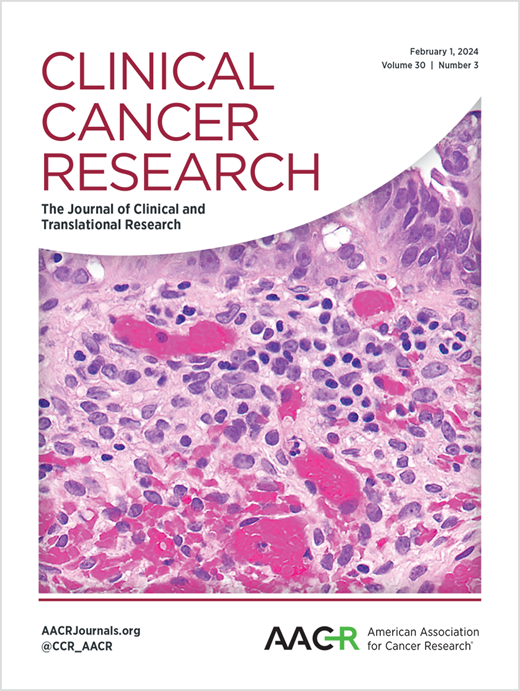Clonal hematopoiesis of indeterminate potential influences breast cancer outcomes in a genotype-specific manner.
IF 10.2
1区 医学
Q1 ONCOLOGY
引用次数: 0
Abstract
PURPOSE Clonal hematopoiesis of indeterminate potential (CHIP) has been associated with adverse outcomes in some solid tumor settings, but its impact on breast cancer remains unclear. We sought to investigate the genotype-specific effects of CHIP on breast cancer outcomes and the tumor microenvironment. EXPERIMENTAL DESIGN We examined a retrospective cohort of 125 patients with breast cancer, using targeted sequencing to identify CHIP. Metastatic events were recorded, and distant metastasis-free survival probability was analyzed. In parallel, we developed chimeric mouse models of the two most mutated CHIP genes, DNMT3A and TET2. CHIP and control mice were orthotopically injected with syngeneic breast cancer cells. Tumor growth was measured, and immune infiltrate was profiled via mass cytometry. RESULTS CHIP was present in 18.4% of patients. High-burden CHIP and non-DNMT3A CHIP were associated with significantly shorter distant metastasis-free survival. In vivo, mice with Tet2-CHIP developed larger primary tumors and were more likely to experience lung metastasis, while Dnmt3a-CHIP did not differ from controls. The general immune subsets observed in both CHIP models were similar, but immunophenotyping revealed clonal expansion and immune cell subset skewing specific to the Tet2-CHIP model. CONCLUSIONS Our findings demonstrate a genotype-specific impact of CHIP on breast cancer across human and mouse data. Further, the chimeric mouse models we generated offer a clinically relevant tool to study solid tumors in a CHIP background. This work underscores the need for further functional studies and personalized risk assessment to clearly define the impact of various CHIP genotypes on breast cancer.不确定的克隆造血以基因型特异性的方式影响乳腺癌的预后。
目的:在一些实体肿瘤中,不确定潜能的区域性造血(CHIP)与不良结局相关,但其对乳腺癌的影响尚不清楚。我们试图研究CHIP对乳腺癌预后和肿瘤微环境的基因型特异性影响。实验设计我们研究了125例乳腺癌患者的回顾性队列,使用靶向测序来鉴定CHIP。记录转移事件,并分析远端无转移生存率。同时,我们开发了两个最易突变的CHIP基因DNMT3A和TET2的嵌合小鼠模型。CHIP和对照小鼠原位注射同基因乳腺癌细胞。测量肿瘤生长情况,并通过细胞计数法检测免疫浸润。结果18.4%的患者存在schip。高负荷CHIP和非dnmt3a CHIP与远端无转移生存期显著缩短相关。在体内,Tet2-CHIP小鼠的原发肿瘤更大,更容易发生肺转移,而Dnmt3a-CHIP与对照组没有差异。在两种CHIP模型中观察到的一般免疫亚群相似,但免疫表型分析显示Tet2-CHIP模型特异性的克隆扩增和免疫细胞亚群倾斜。我们的研究结果表明,CHIP对人类和小鼠乳腺癌具有基因型特异性影响。此外,我们生成的嵌合小鼠模型为在CHIP背景下研究实体肿瘤提供了临床相关的工具。这项工作强调需要进一步的功能研究和个性化风险评估,以清楚地确定各种CHIP基因型对乳腺癌的影响。
本文章由计算机程序翻译,如有差异,请以英文原文为准。
求助全文
约1分钟内获得全文
求助全文
来源期刊

Clinical Cancer Research
医学-肿瘤学
CiteScore
20.10
自引率
1.70%
发文量
1207
审稿时长
2.1 months
期刊介绍:
Clinical Cancer Research is a journal focusing on groundbreaking research in cancer, specifically in the areas where the laboratory and the clinic intersect. Our primary interest lies in clinical trials that investigate novel treatments, accompanied by research on pharmacology, molecular alterations, and biomarkers that can predict response or resistance to these treatments. Furthermore, we prioritize laboratory and animal studies that explore new drugs and targeted agents with the potential to advance to clinical trials. We also encourage research on targetable mechanisms of cancer development, progression, and metastasis.
 求助内容:
求助内容: 应助结果提醒方式:
应助结果提醒方式:


